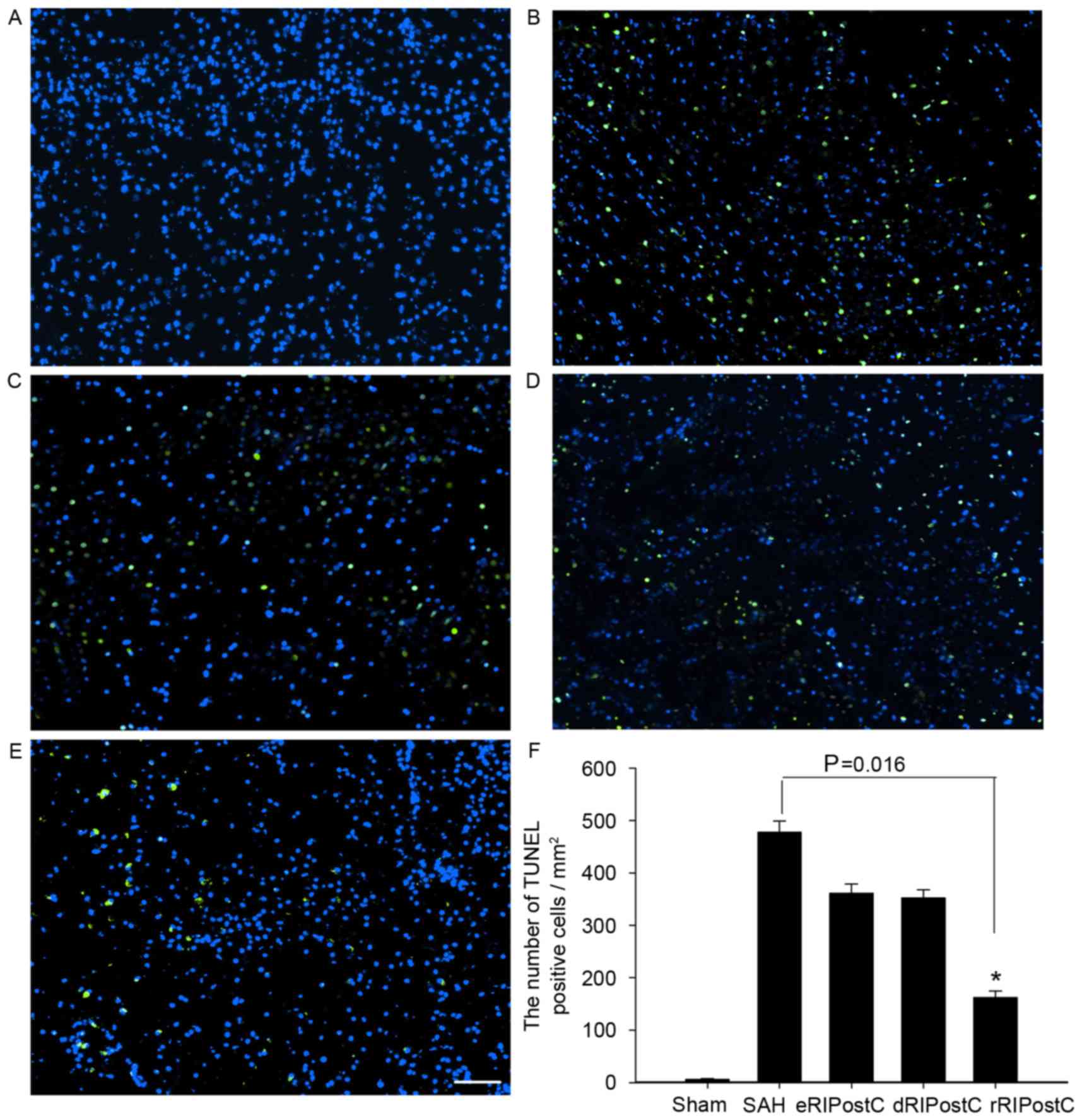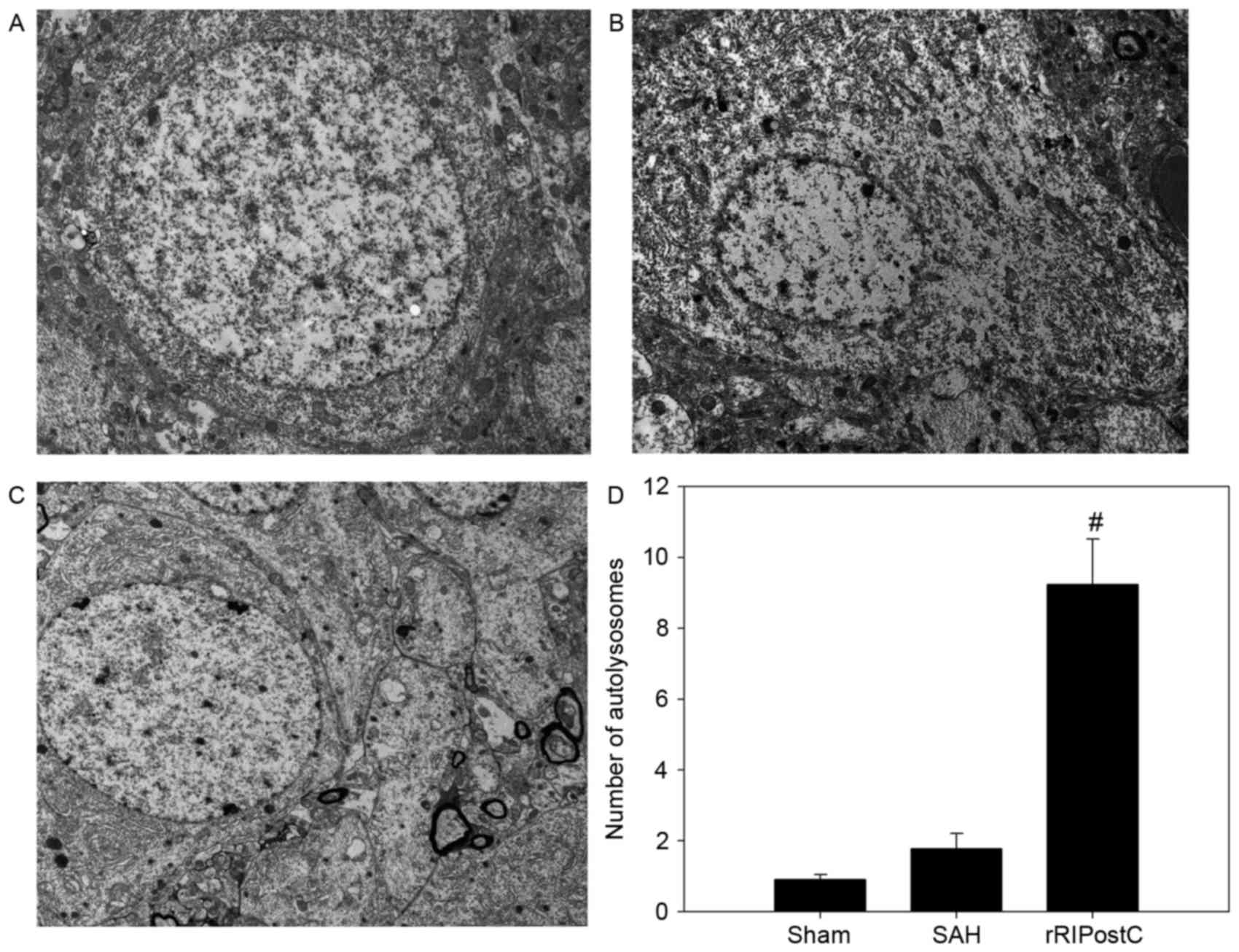|
1
|
Feigin VL, Lawes CM, Bennett DA,
Barker-Collo SL and Parag V: Worldwide stroke incidence and early
case fatality reported in 56 population-based studies: A systematic
review. Lancet Neurol. 8:355–369. 2009. View Article : Google Scholar
|
|
2
|
Ostrowski RP, Colohan AR and Zhang JH:
Molecular mechanisms of early brain injury after subarachnoid
hemorrhage. Neurol Res. 28:399–414. 2006. View Article : Google Scholar
|
|
3
|
Dorsch N: A clinical review of cerebral
vasospasm and delayed ischaemia following aneurysm rupture. Acta
Neurochir Suppl. 110:5–6. 2011.
|
|
4
|
Andreka G, Vertesaljai M, Szantho G, Font
G, Piroth Z, Fontos G, Juhasz ED, Szekely L, Szelid Z, Turner MS,
et al: Remote ischaemic postconditioning protects the heart during
acute myocardial infarction in pigs. Heart. 93:749–752. 2007.
View Article : Google Scholar :
|
|
5
|
Burda R, Danielisova V, Gottlieb M,
Nemethova M, Bonova P, Matiasova M, Morochovic R and Burda J:
Delayed remote ischemic postconditioning protects against transient
cerebral ischemia/reperfusion as well as kainate-induced injury in
rats. Acta Histochem. 116:1062–1067. 2014. View Article : Google Scholar
|
|
6
|
Peng B, Guo QL, He ZJ, Ye Z, Yuan YJ, Wang
N and Zhou J: Remote ischemic postconditioning protects the brain
from global cerebral ischemia/reperfusion injury by up-regulating
endothelial nitric oxide synthase through the PI3K/Akt pathway.
Brain Res. 1445:92–102. 2012. View Article : Google Scholar
|
|
7
|
Wang Q, Zhang X, Ding Q, Hu B, Xie Y, Li
X, Yang Q and Xiong L: Limb remote postconditioning alleviates
cerebral reperfusion injury through reactive oxygen
species-mediated inhibition of delta protein kinase C in rats.
Anesth Analg. 113:1180–1187. 2011. View Article : Google Scholar
|
|
8
|
Liu X, Zhao S, Liu F, Kang J, Xiao A, Li
F, Zhang C, Yan F, Zhao H, Luo M, et al: Remote ischemic
postconditioning alleviates cerebral ischemic injury by attenuating
endoplasmic reticulum stress-mediated apoptosis. Transl Stroke Res.
5:692–700. 2014. View Article : Google Scholar
|
|
9
|
Rubinsztein DC, DiFiglia M, Heintz N,
Nixon RA, Qin ZH, Ravikumar B, Stefanis L and Tolkovsky A:
Autophagy and its possible roles in nervous system diseases, damage
and repair. Autophagy. 1:11–22. 2005. View Article : Google Scholar
|
|
10
|
Shao BZ, Wei W, Ke P, Xu ZQ, Zhou JX and
Liu C: Activating cannabinoid receptor 2 alleviates pathogenesis of
experimental autoimmune encephalomyelitis via activation of
autophagy and inhibiting NLRP3 inflammasome. CNS Neurosci Ther.
20:1021–1028. 2014. View Article : Google Scholar
|
|
11
|
Wang P and Miao CY: Autophagy in the
disorders of central nervous system: Vital and/or fatal? CNS
Neurosci Ther. 18:955–956. 2012. View Article : Google Scholar
|
|
12
|
Kubota C, Torii S, Hou N, Saito N,
Yoshimoto Y, Imai H and Takeuchi T: Constitutive reactive oxygen
species generation from autophagosome/lysosome in neuronal
oxidative toxicity. J Biol Chem. 285:667–674. 2010. View Article : Google Scholar
|
|
13
|
Liu J, Wang F, Liu Y, He G, Chen J and Zhu
F: Retrospective study of cerebral vasospasm-related risk factors
in elderly patients with subarachnoid hemorrhage. Neurosurg Quart.
20:258–262. 2010. View Article : Google Scholar
|
|
14
|
Luo S, Zhang X, Yu M, Yan H, Liu H, Wilson
JX and Huang G: Folic acid acts through DNA methyltransferases to
induce the differentiation of neural stem cells into neurons. Cell
Biochem Biophys. 66:559–566. 2013. View Article : Google Scholar
|
|
15
|
Bederson JB, Germano IM and Guarino L:
Cortical blood flow and cerebral perfusion pressure in a new
noncraniotomy model of subarachnoid hemorrhage in the rat. Stroke.
26:1086–1092. 1995. View Article : Google Scholar
|
|
16
|
Sugawara T, Ayer R, Jadhav V and Zhang JH:
A new grading system evaluating bleeding scale in filament
perforation subarachnoid hemorrhage rat model. J Neurosci Methods.
167:327–334. 2008. View Article : Google Scholar
|
|
17
|
Frontera JA, Ahmed W, Zach V, Jovine M,
Tanenbaum L, Sehba F, Patel A, Bederson JB and Gordon E: Acute
ischaemia after subarachnoid haemorrhage, relationship with early
brain injury and impact on outcome: A prospective quantitative MRI
study. J Neurol Neurosurg Psychiatry. 86:71–78. 2015. View Article : Google Scholar
|
|
18
|
Selim M and Wang M: Ischemic
preconditioning: The long-awaited savior of Neuroprotection. Has It
Arrived? Neurotherapeutics. 12:655–656. 2015. View Article : Google Scholar :
|
|
19
|
Buchholz B, Donato M, D'Annunzio V and
Gelpi RJ: Ischemic postconditioning: Mmechanisms, comorbidities,
and clinical application. Mol Cell Biochem. 392:1–12. 2014.
View Article : Google Scholar
|
|
20
|
Zhao H: The protective effects of ischemic
postconditioning against stroke: From rapid to delayed and remote
postconditioning. Open Drug Discov J. 5:138–147. 2011.
|
|
21
|
Geng X, Ren C, Wang T, Fu P, Luo Y, Liu X,
Yan F, Ling F, Jia J, Du H, et al: Effect of remote ischemic
postconditioning on an intracerebral hemorrhage stroke model in
rats. Neurol Res. 34:143–148. 2012.
|
|
22
|
Sun J, Tong L, Luan Q, Deng J, Li Y, Li Z,
Dong H and Xiong L: Protective effect of delayed remote limb
ischemic postconditioning: Role of mitochondrial K(ATP) channels in
a rat model of focal cerebral ischemic reperfusion injury. J Cereb
Blood Flow Metab. 32:851–859. 2012. View Article : Google Scholar :
|
|
23
|
Xu J, Sun S, Lu X, Hu X, Yang M and Tang
W: Remote ischemic pre- and postconditioning improve
postresuscitation myocardial and cerebral function in a rat model
of cardiac arrest and resuscitation. Crit Care Med. 43:e12–e18.
2015. View Article : Google Scholar
|
|
24
|
Perera Drunalini PN, Hu Q and Tang J, Li
L, Barnhart M, Doycheva DM, Zhang JH and Tang J: Delayed remote
ischemic postconditioning improves long term sensory motor deficits
in a neonatal hypoxic ischemic rat model. PLoS One. 9:e902582014.
View Article : Google Scholar :
|
|
25
|
Sun J, Tong L, Luan Q, Deng J, Li Y, Li Z,
Dong H and Xiong L: Protective effect of delayed remote limb
ischemic postconditioning: Role of mitochondrial K(ATP) channels in
a rat model of focal cerebral ischemic reperfusion injury. J Cereb
Blood Flow Metab. 32:851–859. 2012. View Article : Google Scholar :
|
|
26
|
Lee Y, He Y, Sagher O, Keep R, Hua Y and
Xi G: Activated autophagy pathway in experimental subarachnoid
hemorrhage. Brain Res. 1287:126–135. 2009. View Article : Google Scholar
|
|
27
|
Takagi H, Matsui Y, Hirotani S, Sakoda H,
Asano T and Sadoshima J: AMPK mediates autophagy during myocardial
ischemia in vivo. Autophagy. 3:405–407. 2007. View Article : Google Scholar
|
|
28
|
Han Z, Cao J, Song D, Tian L, Chen K, Wang
Y, Gao L, Yin Z, Fan Y and Wang C: Remote limb ischemic
postconditioning on myocardial ischemia/reperfusion injury in
normal mice, but not diabetic mice. PLoS One. 9:e868382014.
View Article : Google Scholar :
|
|
29
|
Qi ZF, Luo YM, Liu XR, Wang RL, Zhao HP,
Yan F, Song ZJ, Luo M and Ji XM: AKT/GSK3β-dependent autophagy
contributes to the neuroprotection of limb remote ischemic
postconditioning in the transient cerebral ischemic rat model. CNS
Neurosci Ther. 18:965–973. 2012. View Article : Google Scholar
|
|
30
|
Zhao GX, Pan H, Ouyang DY and He XH: The
critical molecular interconnections in regulating apoptosis and
autophagy. Ann Med. 47:305–315. 2015. View Article : Google Scholar
|
|
31
|
Granato M, Chiozzi B, Filardi MR, Lotti
LV, Di Renzo L, Faggioni A and Cirone M: Tyrosine kinase inhibitor
tyrphostin AG490 triggers both apoptosis and autophagy by reducing
HSF1 and Mcl-1 in PEL cells. Cancer Lett. 366:191–197. 2015.
View Article : Google Scholar
|
|
32
|
Katsiougiannis S, Tenta R and Skopouli FN:
Endoplasmic reticulum stress causes autophagy and apoptosis leading
to cellular redistribution of the autoantigens Ro/Sjögren's
syndrome-related antigen A (SSA) and La/SSB in salivary gland
epithelial cells. Clin Exp Immunol. 181:244–252. 2015. View Article : Google Scholar :
|
|
33
|
Cui J, Hu YF, Feng XM, Tian T, Guo YH, Ma
JW, Nan KJ and Zhang HY: EGFR inhibitors and autophagy in cancer
treatment. Tumor Biol. 35:11701–11709. 2014. View Article : Google Scholar
|
|
34
|
Cursio R, Colosetti P and Gugenheim J:
Autophagy and liver ischemia-reperfusion injury. Biomed Res Int.
2015:4175902015. View Article : Google Scholar :
|

















